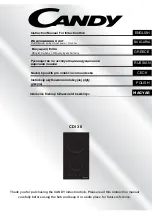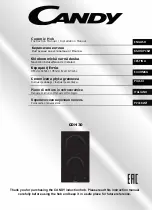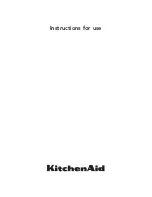
be used in other applications and are not
suitable for household room illumination.
DISPOSAL
WARNING! Risk of injury or
suffocation.
• Contact your municipal authority for information
on how to discard the appliance correctly.
• Disconnect the appliance from the mains
supply.
• Cut off the mains electrical cable close to the
appliance and dispose of it.
• Flat the external gas pipes.
INSTALLATION
WARNING! Refer to Safety chapters.
BEFORE THE INSTALLATION
Before you install the hob, write down the
information bellow from the rating plate. The rating
plate is on the bottom of the hob.
Model .......................................
PNC .........................................
Serial number ...........................
GAS CONNECTION
WARNING! The following instructions
about installation, connection and
maintenance must be carried out by
qualified personnel in compliance with
standards and local regulations in
force.
Choose fixed connections or use a flexible pipe in
stainless steel in compliance with the regulation in
force. If you use flexible metallic pipes, be careful
they do not come in touch with mobile parts or they
are not squeezed. Also be careful when the hob is
put together with an oven.
Make sure that the gas supply
pressure of the appliance obeys the
recommended values. The adjustable
connection is fixed to the
comprehensive ramp by means of a
threaded nut G 1/2". Screw the parts
without force, adjust the connection in
the necessary direction and tighten
everything.
A
B
C
A. End of shaft with nut
B. Washer supplied with the appliance
C. Elbow supplied with the appliance
WARNING! It is important to install
the elbow correctly. Make sure that the
shoulder is on the end of the thread.
Then install it on the hob connecting
pipe. Incorrect assembly may cause a
gas leakage.
Liquid gas
Use the rubber pipe holder for liquid gas. Always
engage the gasket. Then continue with the gas
connection.
The flexible pipe is prepared for apply when:
• it can not get hot more than room temperature,
higher than 30°C;
• it is no longer than 1500 mm;
• it shows no throttles;
• it is not subject to traction or torsion;
• it does not get in touch with cutting edges or
corners;
• it can be easily examined in order to make sure
its condition.
The control of preservation of the flexible pipe
consists in checking that:
• it does not show cracks, cuts, marks of burnings
on the two ends and on its full length;
• the material is not hardened, but shows its
correct elasticity;
• the fastening clamps are not rusted;
• expired term is not due.
If one or more defects are visible, do not repair the
pipe, but replace it.
6







































